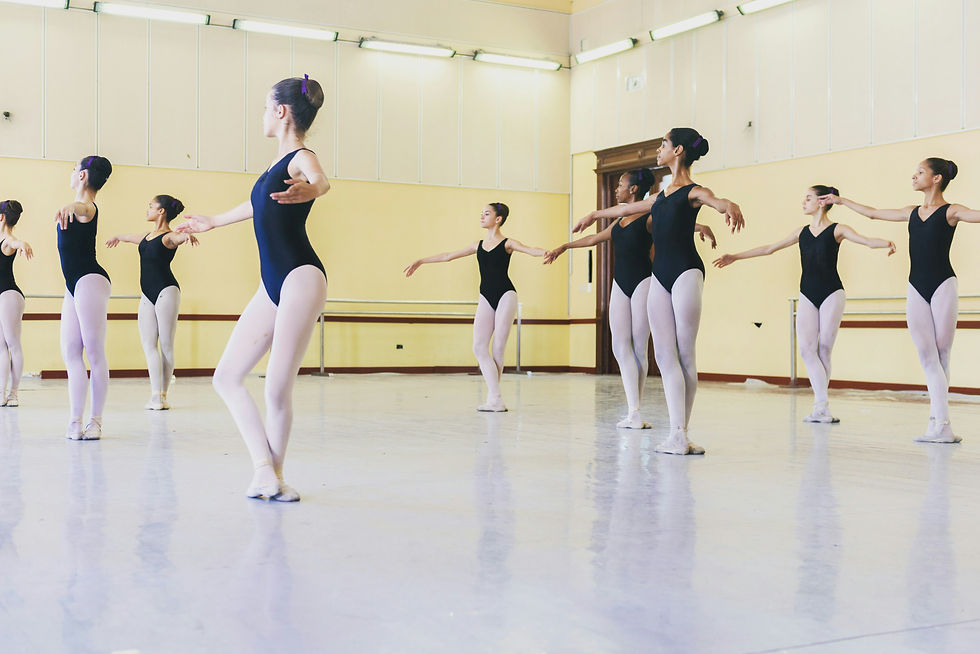Ready for Pointe? 3 Functional Tests Every Dance Teacher Should Know
- Rebecca Brown
- Jun 30
- 3 min read
Quick Highlights:
Chronological age isn’t enough—readiness for pointe varies widely and can’t be judged by age alone.
No single test determines readiness, but three functional tests closely aligned with teacher assessments.
Airplane, Sauté, and Topple tests assess core control, balance, alignment, and technique.
Teacher expertise is essential—these tests are tools to support, not replace, professional judgment.
“When can they start pointe?”
It’s a familiar question—one that dance teachers are asked regularly. While many studios still look to age 12 as a benchmark, we now know that readiness for pointe can’t be determined by age or years of training alone. Every dancer develops at a different rate, and what’s safe for one may not be for another.
A study published in the Journal of Dance Medicine & Science, titled "Functional Criteria for Assessing Pointe-Readiness", explored whether simple functional tests could support teachers in making more informed decisions about when a dancer is ready for pointe work. The aim wasn’t to replace teacher insight, but rather to provide evidence-based tools that complement and reinforce what experienced teachers already observe in the studio.

Why Age Isn’t Enough
Although age 12 is often cited as the starting point for pointe, the study confirmed what many teachers already know: chronological age is not a reliable indicator. Physical maturity, motor control, and alignment vary significantly, especially during puberty, when rapid growth can temporarily reduce coordination and balance.
This reinforces the importance of assessing the individual dancer, not just checking off an age-based milestone.
The 3 Tests That Matter:
Researchers assessed nine different screening tools related to strength, control, balance, and technique. Three tests stood out for their strong alignment with teacher assessments of pointe-readiness:
1. Airplane Test
A single-leg test that mimics a forward-pitched arabesque with plié and fingertip tap to the floor. It challenges core stability, balance, and lower limb alignment. → Dancers who struggled with this test were more often considered not yet ready.
2. Sauté Test
Sixteen consecutive single-leg sautés, judged on form, landing control, and endurance. → Dancers who performed well were more likely to be classified as ready for pointe.
3. Topple Test
A controlled single pirouette from fourth into retiré with a strong, balanced landing. → Performance on this test closely reflected teacher decisions and technical readiness.

A Tool, Not a Rule:
Let’s be clear—no single test can fully determine pointe readiness. But these functional assessments offer valuable insights into a dancer’s control, alignment, and technical preparedness. Most importantly, they strongly reflect what teachers are already seeing.
Your professional judgment is irreplaceable. These tests are simply an added layer of support—to guide conversations with dancers and families, track progress, and make confident, evidence-informed decisions.
A Pre-Pre-Pointe Assessment:
In day-to-day teaching, these tests can also be a great way to check whether a dancer is on track before attending their formal pre-pointe assessment. They give teachers a simple, structured way to spot if key foundations—like alignment, control, and technique—are developing as expected.
Instead of waiting until the assessment to uncover any strength or stability gaps, these tests can help you identify areas to work on ahead of time. That way, dancers can go into their assessment feeling more prepared, more confident, and with a better chance of success.
Final Thoughts:
Pointe work is a major milestone
in a dancer’s training, but it should never be rushed. With a combination of teacher expertise and structured functional testing, you can ensure that dancers transition to pointe when they’re truly ready—physically, technically, and emotionally.
Reference:
Richardson, M., Liederbach, M., & Sandow, E. (2010). Functional criteria for assessing pointe-readiness. Journal of Dance Medicine & Science, 14(3), 82–88.




Comments